足回りのメンテナンスと手入れ
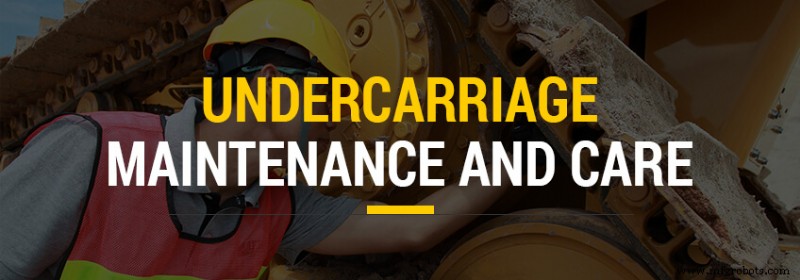
トラックに依存する重機を所有または操作している場合、足回りが機器の重要な部分。クロール機器は複雑で、過酷で重い条件に耐えるように作られています。ただし、永久に使用できる機器はありません。足回りのメンテナンスとケアに費やす労力は、コンポーネントの寿命を延ばし、作業時間を継続するという点で非常に大きな見返りがあります。
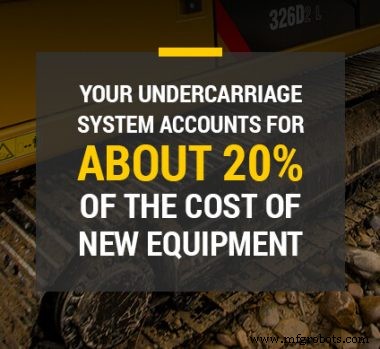 トラック上を這う重機は、大規模で重要な投資です。車台システムは、新しい機器のコストの約 20% を占めています。対照的に、足回りはメンテナンス予算の約 50% を占めます。機器への投資を最大限に活用するには、車台の適切な予防保守が不可欠です。
トラック上を這う重機は、大規模で重要な投資です。車台システムは、新しい機器のコストの約 20% を占めています。対照的に、足回りはメンテナンス予算の約 50% を占めます。機器への投資を最大限に活用するには、車台の適切な予防保守が不可欠です。
足回りのメンテナンスは、定期的な足回りの検査を行うだけではありません。足回り管理の 2 つの主な原則は、それを清潔に保ち、適切な張力を維持することです。これらの重要なポイント以外にも、アプリケーション、地形、オペレーターの技術、仕事に適したトラックの使用など、時間の経過とともに機器の摩耗に影響を与える可能性のある多くの要因があります.
自分の仕事に適したトラックを選択
地ならし機器の技術は進歩し、進化し続けています。今日の機器は、過去の掘削機、ドーザー、コンパクト トラック ローダーよりもはるかに信頼性と耐久性に優れています。これで、トラック オプションの優れた選択ができました。オペレーションを成功させるための鍵は、独自のニーズに適したオプションを選択することです。
機器を操作する条件は大きく異なる可能性があるため、普遍的なトラックなどというものはありません。柔らかい砂や泥から、トラックを噛む岩や解体のがれきまで、あらゆるものを体験できます。
エンジニアは、重量を効果的に移動するように機器のトラックを設計します。トラック装備の機器は、車輪付きの機器よりもフットプリントがはるかに小さく、接地圧が低く、牽引力も高くなります。ただし、トラックは表面によっては硬くなることがあります。そのため、キャタピラーなどの主要な機器メーカーは、次の 2 つのトラック素材オプションから選択できます。
<オール>
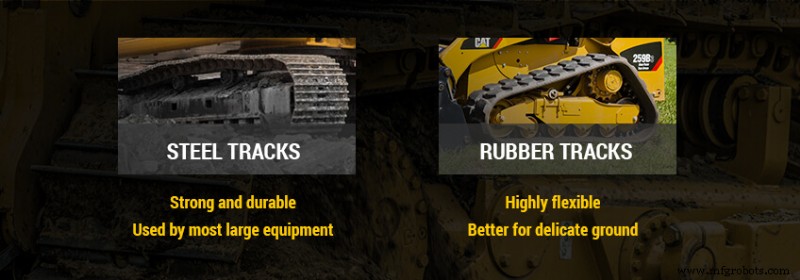
ゴムまたはスチールのどちらで走っていても、重要な必要な足回りのサポート。足回りコンポーネントにより、クロール、方向転換、直立を維持できます。また、トラックの位置合わせと適切な張力バランスを提供して、機器が確実に機能するようにします。
スチール製またはゴム製の履帯は、設計された寿命内では信頼できるかもしれませんが、車台は常に脆弱です。足回りは複雑な可動部品のシステムであり、故障を防ぐために特別な注意が必要です。足回りの故障は壊滅的であり、修理には非常に費用がかかります。
故障を防ぐことが、足回りのメンテナンス プログラムのすべてです。足回りのパーツだけでなく、トラックが教えてくれることにも細心の注意を払う必要があります。プログラムの重要な部分は、車台の摩耗に影響を与える要因と、早期の摩耗を防ぐために何ができるかを理解することです.
車台の摩耗に影響する要因
すべての下部構造コンポーネントは時間の経過とともに自然に摩耗し、サービスの期待値は限られています。
足回りの摩耗には、特定の時間制限はありません。稼働時間で耐用年数を測定しますが、機器の下部構造がどれくらい持続するかについての一定のレートはありません。コンポーネントの寿命は、現場で経験するさまざまな要因に大きく左右されます。車台の摩耗に影響を与える主な要因は次のとおりです。
- アプリケーション: この要因は、機器を使用して完了する作業の種類を指します。アプリケーションは、部品にかかる応力とひずみに大きな影響を与えます。典型的な現場での用途には、掘削または溝掘り、居眠りまたは押し込み、引き裂き、積み込み、運搬および整地が含まれます。一部のアプリケーションは、他のアプリケーションよりも足回りに負担をかけます。重要な要素は、駆動システムを介して動力部品から伝達されるトルクです。原則として、仕事に必要なトルクが大きいほど、車台の摩耗が大きくなります。
- 地形: 機器が直面する地形を制御できることはめったにありません。通常、あなたの装備は地形を変えるためにあります。事前設定された条件内で機能する必要があり、それらの条件のいくつかは、足回りの制限をテストできます。車台の地形による摩耗は、丘、斜面、クラウン、くぼみでの作業によって発生します。コンポーネントを実際に摩耗させるのは、地形の変化によって車台が経験する抵抗力です。
- 足元: 困難な地形に加えて、足回りが経験する足元の状態があります。あなたのトラックは、磨耗した岩や粗い破片から最前線の虐待を受けます。トラックは足元の素材を足回りに送り込み、摩耗を引き起こします。砂のような足元の状態は、ゴムであろうとスチールであろうと、トラックが柔らかくて簡単に見えるかもしれません。ただし、砂は非常に摩耗性が高く、移動する下部構造部品を削り取るため、摩耗が激しくなり、寿命が短くなります。足元の脅威から足回りを乗り切る秘訣は、定期的な清掃です。
- 操作: 足回りへの脅威は、用途、地形、足元の状態だけではありません。多くの摩耗は、機器の操作方法に起因します。積極的な操作は、足回りの摩耗に影響を与える大きな要因です。
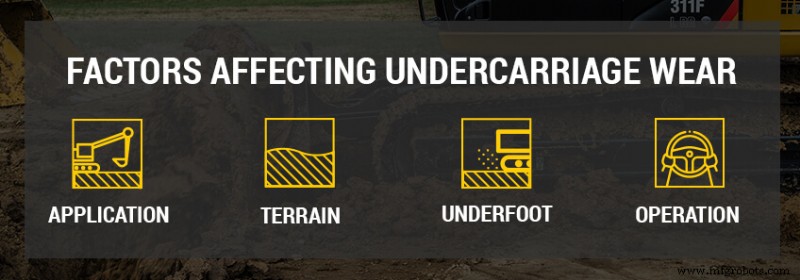
オペレータが責任を持って機器を操作するようにトレーニングすることで、不要な下部構造の摩耗を簡単に防ぐことができます。オペレーターを監視することで、オペレーターの摩耗を最小限に抑えることもできます。この介入だけでも、車台の維持費と修理費を大幅に節約できます。
適切なトラック機器の操作
ほとんどの機器オペレーターは、危害を加えるつもりはありません。オペレーターの被害は、多くの場合、経験不足または適切なトレーニングの欠如から生じます。機器の下部構造を摩耗させるオペレーターが犯す主な間違いには、次のものがあります。
- 仕事を迅速に終わらせるために積極的に行動する
- 現場の状況や指定された速度制限に対して速すぎる
- フロント アイドラーの代わりにリア ドライブ スプロケットに掘削力を加える
- 機器の側面から掘削し、足回りにクロス テンションをかける
- 柔らかい足元や地形条件でトラックを滑らせたりスピンさせたりする
- 機器を一方向に連続的に回転させ、交互に回転させない
- ドライブに間違った方向の力をかける、不必要に後進する
- 機器を平準化して力を均等にするのではなく、勾配や斜面での作業
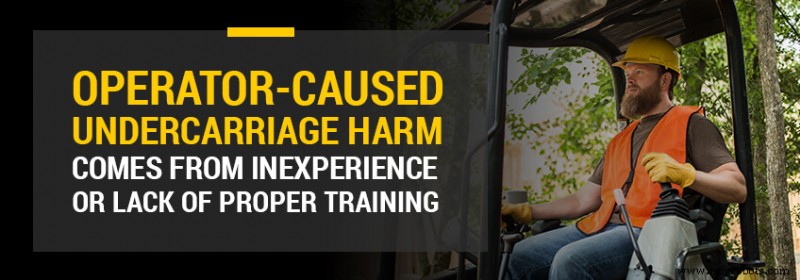
車台が動くたびに、コンポーネントが摩耗します。しかし、部品は摩耗して交換することが予想されますが、寿命を延ばすための措置を講じることができないわけではありません。オペレーターを教育し、彼らを車台整備プログラムの一部にするために費やした努力は、あなたに報いるでしょう。従業員が実行できる主な手順の 1 つは、毎日の車台検査の実施です。
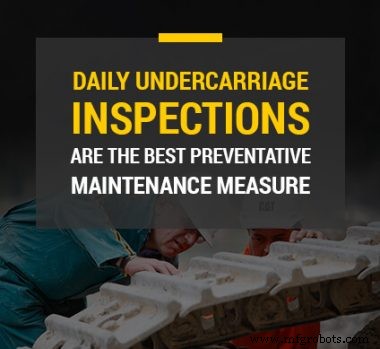 毎日の車台検査
毎日の車台検査
機器オペレーターがあなたのフリートに個人的な利害関係を持っている場合、彼らはそれを正しく扱う可能性がはるかに高くなります.彼らは、下部構造への横方向のストレスを回避し、後部ドライブに掘削力をかけないなど、適切な操作手順に注意を払います。生産的に作業するのに十分な速度で移動しますが、コンポーネントの摩耗を防ぐのに十分な速度です。
オペレータは機器の最も近くにいて、トラブルが発生し始めたときに早期に警告を発する優れた情報源です。オペレーターが潜在的な問題をすぐに報告するように奨励してください。通常は、毎日の車台検査で問題を発見している可能性があります。
車台を毎日検査することは、チームが実行できる最善の予防保守対策の 1 つです。検査にはそれほど時間はかかりませんが、長期的な見返りがあります。日常の車台点検を行う際にチェックする主なポイントは次のとおりです。
- 離れて全体を見て、場違いに見えるものを特定します。
- 個々の部品を見る前に、機器の周りを一周してください。
- 油漏れや滴り落ちている可能性のある不自然な湿りを探します。
- シールの漏れやグリース フィッティングの損傷を詳しく調べてください。
- スプロケットの歯の摩耗やボルトの緩みをチェックします。
- アイドラー、ガイド プレート、ローラー、リンクに緩みや欠品がないか点検します。
- 下部構造のフレームに応力亀裂の兆候がないか注意してください。
- 車台レールをチェックし、へこみの摩耗を探します。
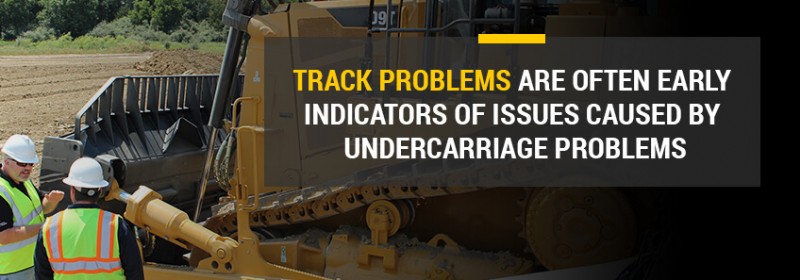
日常点検でチェックする機器の部分は、車台だけではありません。あなたの足跡も注目しておくことが重要です。トラックの問題は、多くの場合、足回りの問題によって引き起こされる問題の初期の兆候です。トラックで毎日検査する項目は次のとおりです。
- 靴のひび割れ、破損、緩みを修正し、不足している靴をすぐに交換してください。
- 履帯の張力をチェックし、機器のマニュアルに設定されている公差に従ってください。
- 内向きまたは外向きの傾向を示す線路の配置に注意してください。
- リーディング エッジとトレーリング エッジの靴の摩耗と牽引バーの摩耗を検査する
- 機器を起動し、パフォーマンスを監視しながら各トラックをゆっくりと回転させます。
- ゴム製のクラックがある場合は、ひび割れやほつれがないか探してください。
- スチール トラックの腐食や金属疲労を調べる
トラックは、足回り全体のパフォーマンスに大きな影響を与えます。ほとんどの機器メーカーとオペレーターは、トラックを、スプロケット、ドライブ、リンク、ローラー、アイドラーなどの真の下部構造コンポーネントとはわずかに異なるエンティティと見なしています。履帯と車台アセンブリは技術的には別々のシステムですが、それぞれが相互にサポートしています。
履帯がゴム製であろうとスチール製であろうと、毎日の点検と適切なメンテナンスが必要です。足回りがうまく機能するには、摩耗が少なく、自由に動く部品が必要です。それは、履帯の張りを確実に調整することから始まります。
履帯の張りの調整
車台システムを長持ちさせるには、適切なトラック テンションを維持することが重要です。トラックのテンションは、きつすぎず、ゆるすぎずの完璧なバランスが必要です。これを実現するのは難しい場合があり、適切なトラック テンションは特定の要因によって異なります。
トラックがきつい場合、すべての下部構造コンポーネントに不要な抵抗がかかります。足回りのすべての可動部分と固定部分にストレスがかかります。これにより、摩耗が早くなり、修理に費用がかかります。
トラックが緩すぎると、足回りにもストレスがかかります。ゆるいトラックはさまよい、位置合わせが崩れ、システムに側面のストレスがかかります。きつすぎるのと同じように、トラックが緩んでいると足回りが摩耗し、コストがかかる可能性があります。
適切なトラック テンションの設定は、さまざまな要因によって異なります。履帯の張力は、特定の機器設計、個々の履帯タイプ、および実際の作業条件の問題です。 These are the main factors concerning track tension:
- Track type: Steel or rubber manufacturing materials
- Equipment size: Large hydraulic excavator or small multi terrain loader
- Underfoot conditions: Soft sand or hard rock terrain
- Environmental influences: High or low temperatures and seasonal variances
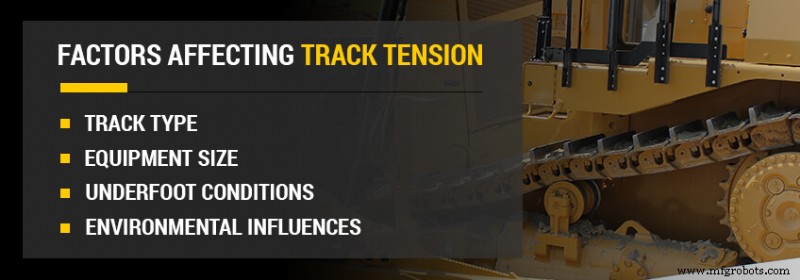
Setting your track tension to get the best performance from your undercarriage can be an art of its own. Track tension is equipment-specific but it has an important influence on your undercarriage wear. The best step you can take is referring to your original equipment manufacturer’s manual like those that come with your Cat
®
equipment.
You’ll likely come across the word “sag” when you’re investigating how to set your track tension. Sag is the dip or drop you’ll see in your track at the upper plane where it’s not affected by ground compression. Your manufacturer will have a sag guide table that gives ideal tolerances for track tension.
You’ll find a lot of variance in track tension tolerances. Big excavators with standard sprocket designs and large steel tracks have different sag rates than rubber-equipped compact track loaders with elevated sprocket designs. When in doubt about track tensions, always contact your equipment dealer for professional advice.
Professional advice from a reputable dealer will save you a lot of headaches when it comes to undercarriage issues. They know the tension tolerances needed for top performance and will always advise you of the most important rule in undercarriage maintenance — keep it clean.
Cleaning Undercarriages
Cleaning your undercarriage is the simplest and safest way to make your undercarriage last as long as possible. Your undercarriage is a complex system of moving parts that can break down when it gets too dirty. Regular cleaning is undercarriage management 101.
It might take a lot of effort to clean your undercarriage components properly, but it’s worth your time. What cleaning is necessary depends on what application you’ve put your tracked equipment through, what terrain you’ve operated it in and what underfoot conditions you’ve moved your tracks through. What’s deposited into your undercarriage assembly is a by-product of work. It’s also a mess that has to come out.
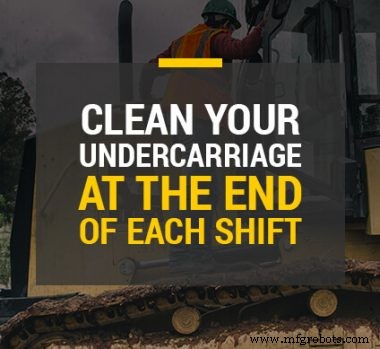 Cleaning your undercarriage is an ongoing event. It’s best to get it done and over with right at the end of each shift. It’s not wise to let a dirty undercarriage sit overnight. In warm weather, gunk can dry and harden. In cold times, it’ll freeze and bind. Either way, it’s going to be a lot harder to clean your undercarriage later than sooner.
Cleaning your undercarriage is an ongoing event. It’s best to get it done and over with right at the end of each shift. It’s not wise to let a dirty undercarriage sit overnight. In warm weather, gunk can dry and harden. In cold times, it’ll freeze and bind. Either way, it’s going to be a lot harder to clean your undercarriage later than sooner.
Dirty undercarriages lead to a number of problems over time. Built-up debris will jam your moving parts and can cause components to snap under protest. Grit also leads to abrasion and premature wear. You’ll also have lower fuel efficiency where there is resistance from clogged tracks and stuck undercarriage parts. Here are some undercarriage cleaning tips to help your preventative maintenance program:
- Use a power washer, if possible, to blast debris from undercarriage parts.
- Use a specially designed track spade to dig out rocks and mud clumps.
- Use a basic hose at the very least to wash components and free-up grit.
- Use compressed air to shoot into your undercarriage assembly.
- Use the track-spinning method to force materials from your equipment centrifugally.
Whatever undercarriage cleaning method you try, make sure you stick with it regularly. Clean undercarriages are long-living assemblies, and they’ll save you a lot of time and money. Cleaning is extremely important for your overall undercarriage preventive maintenance plan.
Track Size and Shoe Importance
It’s always important to bring up track and shoe size when talking about undercarriage maintenance. Having the proper track width and shoe size for your task has a big effect on performance. If your track and shoe combination is oversized, the unnecessary weight and bulk will wear your undercarriage components. If your track and shoe assembly is too small, your flotation rate will suffer, and so will your undercarriage.
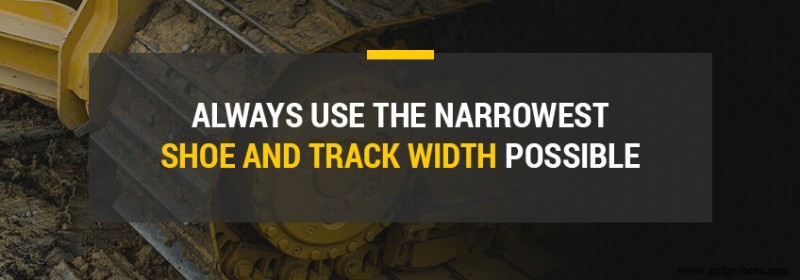
The rule to follow is always to use the narrowest shoe and track width possible. You still want adequate flotation for your terrain and underfoot conditions, but you don’t want to exceed the optimum rate. An oversized track and shoe assembly can cause these undercarriage issues:
- Increased sprocket and busing wear
- Increased wear on flanges, idlers, rollers and links
- Loose pins and shoe hardware
- Track joint life reduction
- Broken shoes and track with failed undercarriage components
Using proper-sized tracks and shoes is an important measure in the fight to keep your undercarriage alive as long as you can. So is keeping your undercarriage clean and always having the proper track tension adjusted for your application. Preventive maintenance is essential for several reasons.
Undercarriage Preventive Maintenance Importance
There are many steps in the undercarriage maintenance process that are essential for ensuring our equipment is at peak performance. Cleaning your undercarriage regularly and adjusting your track tension certainly vital. Lubricating moving parts and replacing components when it’s time are very important as well. Daily inspections also compete for top prevention priority.
Failing to maintain your equipment’s undercarriage is a guarantee to have your equipment fail early. Unfortunately, undercarriages are wear items on all equipment like dozers, excavators and track loaders. But they don’t have to wear out and fail any sooner than necessary.
Undercarriage failure costs are expensive. In addition to repair bills, equipment failures due to poor undercarriage maintenance cost you in job site downtime. They can also cost you in business reputation.
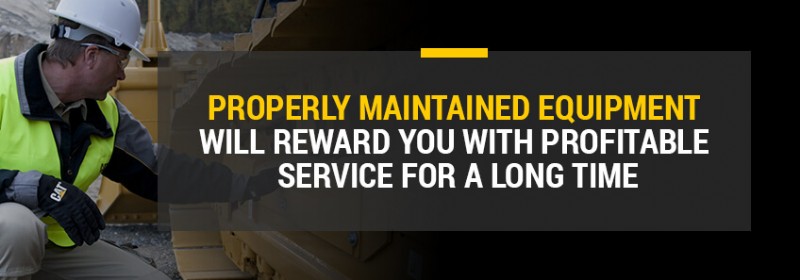
Your reputation, site time and bottom line don’t have to cost you due to undercarriage failure. If you properly maintain your tracked equipment, it will reward you with profitable service for a long time. Consider also partnering with an equipment dealer who knows the value you’ll get with an undercarriage preventive maintenance program.
Video Transcription
Hey, I’m Dave with today’s Quick Tip and I’m here to help you make the most of your investment.
Make inspecting your undercarriage a part of your daily routine.
Look for cracks and damage to the tracks.
Remove excess amounts of dirt and large debris from your undercarriage.
Concrete, rocks and even hardened mud or dirt can increase the fraction your track experiences which will cause wear and may even cause the track to fall off.
Manually extract large items and the occasional power washing will help keep your undercarriage in good shape.
You should also look for loose hardware and oil leaks.
Know the grease points on your specific model.
It is important to grease them daily to lubricate the bushings on your undercarriage frames.
Proper greasing also helps push dirt out.
Tracks should not be too loose or too tight.
Refer to your operation and maintenance manual on the proper tension test procedures for your machine’s specific undercarriage.
Different styles of undercarriage have different tensioning procedures.
The proper track tension will extend the life of your undercarriage.
So remember, for healthy machine undercarriages apply these three simple rules:keep it clean, keep it greased, and keep it tensioned.
Consult your operation and maintenance manuals for more information.
That’s been today’s Quick Tip. Thanks for watching.
Partner With MacAllister Machinery for Undercarriage Maintenance
At MacAllister Machinery, we know how valuable your tracked equipment is. We realize undercarriage maintenance and servicing account for a large chunk of your overall maintenance budget. We want to help you spread your business costs over a long time, and we know that proper undercarriage attention is vital to you.
If your run tracks in Indiana or Michigan’s lower peninsula, partner with MacAllister Machinery for long-term undercarriage management and care. We have the undercarriage service you need to keep your Cat tracks turning and making you a high return on your investment.
Contact MacAllister Machinery today for your undercarriage management solutions. Call us at (317) 545-2151 or contact us online.
機器のメンテナンスと修理



